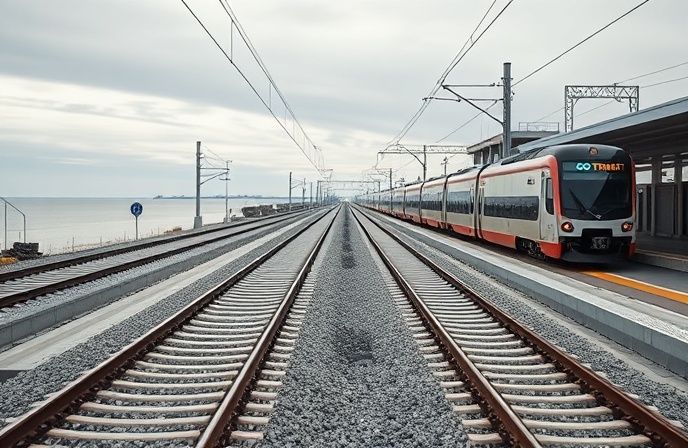Modernizing Railway Infrastructure: Granite Construction OMF East & Trends
Revolutionize your railway infrastructure! Modernization unlocks efficiency, safety, and a superior passenger experience. Discover how!

Optimizing Railway Infrastructure: A Deep Dive into Modernization and Efficiency
The railway industry is undergoing a period of significant transformation, driven by the need for increased efficiency, enhanced safety, and improved passenger experience. This article delves into the key aspects of modernizing railway infrastructure, exploring the challenges, innovative solutions, and the crucial role of project management in ensuring successful implementation. From upgrading track layouts to integrating advanced signaling systems, the focus is on maximizing operational efficiency and minimizing disruptions. A critical aspect of this modernization is the implementation of new technologies to achieve these goals. This includes looking at areas like power supply upgrades, utilizing sustainable materials, and adopting innovative maintenance techniques to ensure long-term viability and cost-effectiveness of rail infrastructure projects. This article will provide insights into the current landscape of railway modernization, focusing particularly on the challenges and opportunities inherent in such projects, and drawing practical lessons from successful implementations. Examining various case studies, such as the Granite Construction OMF East project, will underscore the importance of thorough planning and rigorous project management for delivering high-quality results.
The Imperative for Railway Modernization
The current rail infrastructure in many parts of the world is facing increasing pressure to adapt to growing passenger demand and freight traffic. This necessitates the implementation of modern technologies and techniques to address issues such as ageing infrastructure, inadequate capacity, and operational inefficiencies. Legacy systems often lack the flexibility and scalability required to handle the complexities of contemporary travel patterns. This necessitates the strategic application of advanced digital technologies to optimize the use of existing infrastructure and facilitate its longevity. Effective strategies for tackling these issues require a comprehensive understanding of the specific needs of individual rail systems and the context in which they operate. Modernization efforts must incorporate sustainability, minimizing environmental impact, while maximizing efficiency.
Technological Advancements in Rail Infrastructure
Technological advancements offer significant potential for enhancing railway performance. Advanced signaling systems, such as CBTC (Communication-Based Train Control), reduce delays and improve safety by enabling more precise control over train movements. This increased automation streamlines operations and reduces the need for manual intervention. Furthermore, the use of smart sensors and real-time data analysis allows for proactive maintenance and minimizes unplanned downtime, ensuring efficient and dependable operations. New materials are also being introduced which provide increased strength, durability, and sustainability in railway track construction, signaling, and other infrastructure components. This includes materials like high-strength steel alloys and specialized composites.
Project Management and Successful Implementation
The success of any railway modernization project hinges on robust project management. Effective planning, meticulous budgeting, clear communication, and rigorous quality control are paramount. Risk assessment and contingency planning are critical to mitigating potential disruptions and cost overruns. Furthermore, collaboration between various stakeholders, including government agencies, railway operators, contractors, and the community, is crucial for smooth execution and successful delivery. The seamless integration of all project components is critical to successful implementation.
Case Study: The Granite Construction OMF East Project
The Granite Construction OMF East project exemplifies the challenges and rewards of modern railway infrastructure projects. This project, highlights the complexities of integrating multiple engineering disciplines and managing diverse stakeholders. The intricacies of managing budgets, timelines, and safety protocols, while also considering the potential environmental impacts are crucial to success. Effective risk management, meticulous planning, and consistent communication are paramount to achieving desired outcomes in such large-scale projects.
You might be interested in:
Conclusion
In conclusion, the modernization of railway infrastructure is a multifaceted process demanding careful consideration of technological advancements, project management best practices, and stakeholder collaboration. Projects like the Granite Construction OMF East project underscore the importance of meticulous planning, precise budgeting, and rigorous quality control. The implementation of advanced technologies, such as CBTC, allows for enhanced safety, efficiency, and passenger experience. This modernization is not only crucial for optimizing current operations but also for preparing railway networks for the demands of the future. Success hinges on the ability to manage complex projects, integrating diverse engineering disciplines, and mitigating potential risks. The Granite Construction OMF East project demonstrates the significant challenges and rewards inherent in undertaking these ambitious endeavors. By prioritizing sustainable practices, and carefully considering the broader implications, the industry can ensure a safe, reliable, and sustainable railway system for generations to come. Ultimately, the focus should be on creating a system that not only efficiently moves people and goods but also minimizes environmental impact and promotes long-term viability.



